

ISC - Keep Your Gear Clean in the Wild. Nothing beats getting out and exploring Australia’s wild places – camping, bushwalking, boating or fishing.
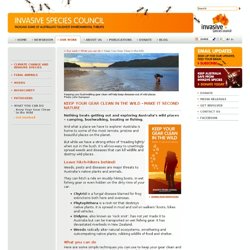
And what a place we have to explore! Australia is home to some of the most remote, pristine and beautiful places on the planet. But while we have a strong ethos of ‘treading lightly’ when out in the bush, it’s all-too-easy to unwittingly spread weeds and diseases that can kill wildlife and destroy wild places. Leave hitch-hikers behind! Weeds, pests and diseases are major threats to Australia’s native plants and animals.
They can hitch a ride on muddy hiking boots, in wet fishing gear or even hidden on the dirty rims of your car. Chytrid is a fungal disease blamed for frog extinctions both here and overseas. What you can do Here are some simple techniques you can use to keep your gear clean and our national parks and other wild places free of deadly pests and diseases: Support us With your help we can educate more Australians about these dangers and protect the wild places we all love. Ontario’s Invading Species Awareness Program. Shipping maps and how states see. I've also had a lot of questions about modern day equivalents to that chart.
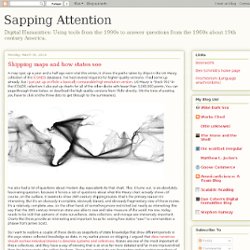
This, it turns out, is an absolutely fascinating question, because it forces a set of questions about what the Maury chart actually shows. Of course, on the surface, it seems to show 19th century shipping routes: that's the primary reason it's interesting. But it's an obviously incomplete, obviously biased, and obviously fragmentary view of those routes. It's a relatively complete view, on the other hand, of something more restricted but nearly as interesting: the way that the 19th century American state was able to see and take measure of the world.
No one, today, needs to be told that patterns of state surveillance, data collection, and storage are immensely important. So I want to explore a couple of these decks as snapshots of state knowledge that show different periods in the ways states collected knowledge as data. So: what's the modern analogue to the Maury map I made?
Cal-IPC: BMPs Transportation and Utility Corridors. Source: California Invasive Plant Council URL of this page: Transportation and utility corridors are at-risk sites for the introduction and spread of noxious and invasive plants.
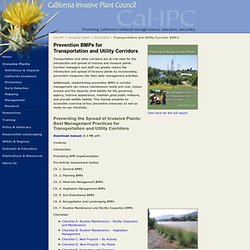
Corridor managers and staff can greatly reduce the introduction and spread of invasive plants by incorporating prevention measures into their daily management activities. Additionally, implementing prevention BMPs in corridor management can reduce maintenance needs and cost, reduce erosion and fire hazards, limit liability for the governing agency, improve appearance, maintain good public relations, and provide wildlife habitat. This manual presents an accessible overview of key prevention measures as well as ready-to-use checklists.
Preventing the Spread of Invasive Plants: Best Management Practices for Transportation and Utility Corridors Download manual (5.3 MB pdf) Contents: IntroductionPrioritizing BMP ImplementationPre-Activity Assessment OutlineCh. 1. Photo courtesy Jack Broadbent, Caltrans Ch. 7.
DOD AFPMB Technical Guides. As a unit of the AFPMB, ISD (Information Services Division) collects, stores and disseminates published and unpublished information on arthropod vectors and pests, natural resources, and environmental biology important to the DoD.
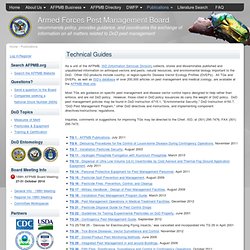
Other ISD products include country- or region-specific Disease Vector Ecology Profiles (DVEPs). All TGs and DVEPs, as well as ISD’s database of over 200,000 articles on pest management and medical zoology, are available at the AFPMB Web site. Most TGs are guidance on specific pest management and disease vector control topics designed to help rather than enforce, and are not DoD policy. However, those cited in DoD policy issuances do carry the weight of DoD policy. DoD pest management policies may be found in DoD Instruction 4715.1, "Environmental Security," DoD Instruction 4150.7, "DoD Pest Management Program," other DoD directives and instructions, and implementing component directives/instructions/ regulations. The Cold, Hard Realities of Arctic Shipping.
• Determine the time frame in which it is likely to happen • Recognize that, at least for commercial interests, economics trumps all As the Russians found out with the failed Shtokman gas field—a €15 billion (roughly $20 billion) Arctic investment killed due to cheap U.S. shale gas—the Arctic is not melting in isolation from events in the rest of the world. 3 It is the global system, of which the Arctic is just one part, that matters; changes across that system, including in the Arctic, interact in ways that can be unpredictable at best.
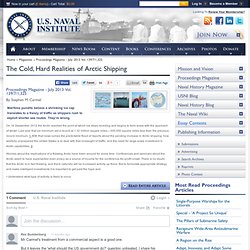
It is very unlikely, then, that the Northern Sea Route across the top of Russia will become a major pathway for the global flow of commerce, and it is virtually certain the Northwest Passage across the top of Canada will never be useful for international trade. There are two types of shipping that must be considered when thinking about commercial traffic through the Arctic: destination shipping and transit shipping. 1. 2. 3. 4. 5.